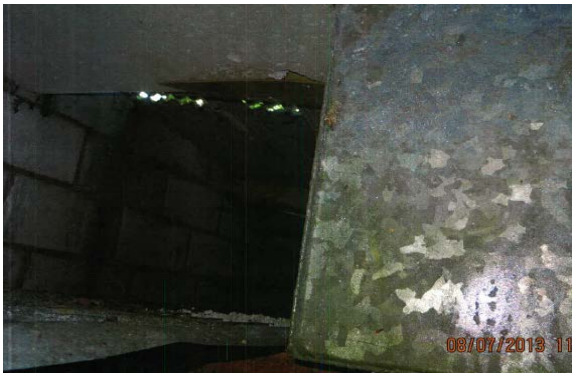Successful prosecution of a relevant person for non-compliance with a Regulation 18 Notice
This case study involves a borehole supplying three properties, one owned by the farmer on whose land the source was located, and which then feeds two separate downstream properties. It was risk assessed and sampled by the local authority in October 2012 and it was deemed to constitute a potential danger to human health. There was broken fencing around the borehole headworks, the headworks itself was not sealed; culminating in evidence of grazing sheep having defecated directly onto the borehole apron as Figure 18 shows. Water was stored in four tanks downstream of the borehole which were found to have no lids, and in a poorly maintained shed. This allowed contamination of the tanks with particles of rust and polystyrene. Figure 19 is an example of holes in the roof of the tanks which allowed the potential for further contamination or vermin to enter.
Figure 18: Area directly around borehole

Figure 19: Storage tank with holes in roof

The results of the sampling confirmed that Enterococci, E.coli and coliforms were all found to be present. A Regulation 18 Notice was served containing health protection actions requiring all water to be boiled before consumption. The Notice also required repairs to be made to the borehole chamber to prevent surface water ingress, together with installation of a stock proof fence, new watertight chamber covers, installation of treatment, new reservoir tanks, vermin-proof overflow pipes and other actions to ensure suitable air gaps and backflow protection were in place. The local authority also provided a copy of the risk assessment, highlighting the key areas of risk.
The local authority arranged meetings to see how work was progressing in December 2012 and March 2013. The owner did not make himself available on either of these occasions, but on one of the visits a further sample was taken from an outdoor sample point which contained Enterococci, E.coli and coliforms. A further visit was undertaken in April 2013 when it became apparent that no work had been done to improve the supply. The local authority liaised with DWI regarding a way forward, and served a Section 80 Notice so that works could be done in default. The owner was contacted again in June, but no progress had been made. The local authority reminded the owner of the obligation to comply with a legal notice. Following information that a quote had been obtained from a local installer for treatment, the Notice was extended until September and the source was sampled again whereupon it was found still to contain Enterococci, E.coli and coliforms. It became apparent that installation of treatment was not being progressed by the owner, so a Regulation 18 Notice was served in October 2013 based on new information from the most recent sampling requiring all water to be boiled before consumption. The Notice also required repairs identified previously to be made.
The owner was invited to attend an interview under caution with the local authority (under the requirements of the Police and Criminal Evidence Act). He did not attend either of two dates set for this meeting. At this point the local authority issued a summons for the owner to appear in court in November. The owner did not respond to any solicitor’s letters and did not turn up for the hearing. Following this, a further summons was issued in February and the case was heard at the Magistrates’ court.
The Magistrate had not previously encountered any cases involving private water supplies and initially thought that the case was just about a breach of a Notice. Once the public health risk was explained by the local authority, they took a very serious view of the offence. The local authority were called into the witness box in order for the Magistrate to understand the difference between actual and potential risk. The local authority pointed to the failed sample results, but said that even if the samples had been clear a Notice would have been served based on the potential risk observed in the assessment.
The Magistrate found in favour of the local authority, and in summing up stated that there was a real risk to public health as downstream properties included young children and elderly residents. The defendant was fined £1,500 plus costs for non-compliance with the Notice, and the Notice was re-served with a deadline of May 2015. Local authority costs claimed were reduced to less than a quarter of the actual costs in order that there would be adequate money to improve the supply. The local authority has requested a meeting with the owner to discuss progress.
This case study highlights the powers that local authorities have at their disposal to regulate private water supplies and protect public health. These powers can ultimately be enforced in a court of law if necessary and incur additional cost for the supply owner.
